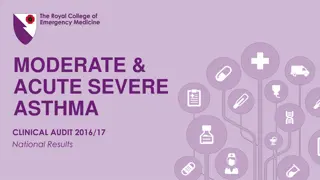National Stroke Audit Acute Services 2023 Hospital Data Presentation
Tailor and present your hospital's data from the National Stroke Audit Acute Services 2023 with an interactive slide deck. Utilize the provided template to display and share results focusing on the Organisational Survey and Clinical Care Indicators. Enhance your presentation by transposing hospital data and aligning with the National Report for comprehensive insights.
Download Presentation

Please find below an Image/Link to download the presentation.
The content on the website is provided AS IS for your information and personal use only. It may not be sold, licensed, or shared on other websites without obtaining consent from the author.If you encounter any issues during the download, it is possible that the publisher has removed the file from their server.
You are allowed to download the files provided on this website for personal or commercial use, subject to the condition that they are used lawfully. All files are the property of their respective owners.
The content on the website is provided AS IS for your information and personal use only. It may not be sold, licensed, or shared on other websites without obtaining consent from the author.
E N D
Presentation Transcript
National Stroke Audit Acute Services 2023 Setting up the slide-deck with your hospital s data This slide-deck can be tailored and used to share and present hospital data to your team and other stakeholders. The template is intended to be interactive, please add or remove slides to suit your hospital s individual requirements. To populate, refer to your hospital s site report to locate your Framework and Clinical Care Indicator results. Transpose your results into each slide and build your presentation. It is recommended all data is read in conjunction with the National Report which will be available to download from https://informme.org.au/stroke-data/Acute-audits
National Stroke Audit Acute Services 2023 (Name) Hospital Results National Stroke Audit Acute Services 2023
The National Stroke Audit - Acute Services is comprised of two elements: The Organisational Survey of acute stroke services across Australia. A retrospective Clinical Audit ofinpatient acute stroke case notes. Examines the resources, processes and infrastructure that support best-practice stroke care. Examines processes of care as outlined in the Clinical Guidelines for Stroke Management Hospitals reviewed case notes for 60 consecutive episodes admitted and discharged between 1 June and 30 November 2023 Enables reporting against each element outlined in the National Acute Stroke Services Framework 2019
National Stroke Audit Acute Services 2023 Organisational Survey Assessing the resources required to deliver evidence-based stroke care against the recommendations from the National Acute Stroke Services Framework 2019
Adherence to the Framework Median number of elements met 1. Plot your hospital s results below by positioning the YELLOW dotted line along the X-axis. 2. Focus on your peer group/similar size hospital median number. 3. Delete this text box My Hospital 17 Australia (N=107) 17 NT (N=2) 500+ stroke patients per annum (N=18) 19 350-499 stroke patients per annum (N=15) 17 200-349 stroke patients per annum (N=31) 17 75-199 stroke patients per annum (N=29) 14 <75 patients per annum (N=14) 11
Organisational Survey Framework 1. Insert your hospital s name and results in the orange column below. 2. Insert your peer group results in the last column below. *Delete this text box similar size services [# sites] n (%) NT National [107 sites] n (%) Your Hospital [2 sites] n (%) Framework Element of Service Receive pre-notification and prepare to rapidly accept potential stroke patient from pre-hospital services 1 (50) 91 (85) Coordinated emergency department systems (includes use of validated screening tools; agreed triage categories; rapid imaging; rapid referral and involvement of stroke team; protocols for IV thrombolysis and ECR intervention/transfer) 2 (100) 92 (86) 1 (50) Stroke unit Rapid access to onsite CT brain (24/7) including CT perfusion and aortic arch to cerebral vertex angiography Delivery of intravenous thrombolysis 86 (80) 2 (100) 89 (83) 2 (100) 96 (90) 0 (0) On-site endovascular stroke therapy (24/7) On-site neurosurgical services (e.g. for hemicraniectomy due to large middle cerebral artery infarcts) Ability to provide acute monitoring (telemetry and other physiological monitoring) for at least 72 hours Acute stroke team 15 (14) 1 (50) 31 (29) 2 (100) 105 (98) 2 (100) 93 (87) 2 (100) Dedicated stroke coordinator position 81 (76)
Organisational Survey Framework 1. Insert your hospital s name and results in the orange column below. 2. Insert your peer group results in the last column below. *Delete this text box similar size services [# sites] n (%) NT National [107 sites] n (%) Your Hospital [2 sites] n (%) Framework Element of Service 2 (100) Dedicated medical lead 78 (73) 2 (100) Access to HDU / ICU (for complex patients) 100 (93) Routine use of carotid (<48 hrs) and brain (<24 hours) imaging and early (<48 hrs) administration of stroke prevention medications (antithrombotics, cholesterol and BP lowering) 2 (100) 87 (81) 2 (100) Use of telehealth services for acute assessment and treatment 77 (72) Standardised processes that ensure ALL stroke patients are assessed for rehabilitation. This includes use of standardised tools to determine individual rehabilitation needs and goals (ideally within 48 hours of admission) 2 (100) 93 (87) Coordination with rehabilitation service providers (this should include a standardised process, and/or a person, used to assess suitability for further rehabilitation) 2 (100) 102 (95) 2 (100) Routine involvement of patients and carers in the rehabilitation process 104 (97) 1 (50) Routine use of guidelines, care plans and protocols 76 (71) 2 (100) Regular data collection and stroke specific quality improvement activities 94 (88) 2 (100) 17/20 Access and collaboration with other specialist services (cardiology, palliative care, vascular) 77 (72) 17/20 Total Elements Met:
National Stroke Audit Acute Services 2023 Clinical Audit Measuring delivery of care as outlined in the Clinical Guidelines for Stroke Management
Clinical Audit Indicators 1. Insert your hospital s name and results in the orange column below. 2. Delete this text box Your Hospital 2023 % or median NT 2023 National 2023 % or median National Benchmark 2023 Acute Stroke Clinical Care Standard Indicator % or median Validated stroke screen in the emergency department 56% 75% 96% Thrombolysis in ischaemic stroke 9% 10% 24% Thrombolysis in ischaemic stroke within 60 mins of hospital arrival 0% 29% 66% Median time from onset to thrombolysis (hours:minutes) 3:05 3:00 - Received stroke unit care (All patients) 41% 72% 96% Received stroke unit care if hospital has a stroke unit 73% 81% 97% Received 90%+ of acute care on a stroke unit (All patients) 27% 48% 83% Received 90%+ of acute care on a stroke unit if hospital has a stroke unit 48% 54% 84%
Clinical Audit Indicators 1. Insert your hospital s name and results in the orange column below. 2. Delete this text box Your Hospital 2023 % or median NT 2023 National 2023 % or median National Benchmark 2023 Acute Stroke Clinical Care Standard Indicator % or median Assessment by a physiotherapist within 24-48 hours of arrival to ED 65% 79% 92% Assessment for ongoing rehabilitation completed using a structured assessment tool prior to discharge 70% 83% 97% Carer received relevant training 67% 62% 89% Carer received support needs assessment 67% 62% 87% Patient received education about behaviour change for modifiable risk factors 33% 72% 96% Antihypertensives on discharge (all stroke types) 72% 82% 95% Lipid-lowering treatment on discharge (ischaemic stroke) 90% 94% 97% Discharge on oral anticoagulants for atrial fibrillation (ischaemic stroke) 83% 79% 87% Antithrombotic on discharge (ischaemic stroke) 96% 99% 98% Care plan developed with the team and the patient (or family alone if patient has severe aphasia or cognitive impairments) 60% 70% 97%
Clinical Audit Indicators Over Time 1. Warning! Dummy Data used below! 2. Click on the graph below, edit data to insert your hospitals progress over time data. 3. Enter your hospital s results from the Indicators over time Tab in your site report. 4. Change colours & style to your liking. 5. Delete this text box 100% 90% 80% 80% 70% 70% 60% 60% 50% 40% 15% 20% 10% 5% 0% 2019 2021 2023 Thrombolysis rate (ischaemic) Stroke Unit Care Care Plan Developed
National Stroke Audit Acute Services 2023 Quality Improvement Action Plan Develop a QI action plan: 1. Identify gaps (recommend picking one indicator for focused QI activity over the next 6-12 months) 2. Identify barriers and enablers 3. Engage stakeholders i.e., managers, clinicians, stroke survivors 4. Document a QI plan - Be specific as to who, will do what, by when 5. Put QI plan into action and monitor progress 6. Re-audit/survey/assess the impact of the QI action plan 7. Sustain/embed improvements Use SMART goals (Specific, Measurable, Achievable, Realistic, and Timely) Set up a regular meeting times to review and get feedback along the way
National Stroke Audit Acute Services 2023 The Stroke Foundation InformMe website brings together a range of resources to support health professionals in delivering the best quality stroke care. On InformMe hospital staff can easily access: Interactive graphsplotting your hospital s audit data against national, state and peer hospitals (similar sized service) averages. Your site-specific report and dashboard from current and previous Audits. Support to create your own quality improvement plans in response to your audit results, plus the opportunity to view quality improvement plans that other hospitals have submitted, https://informme.org.au/Improving-Care Register now: https://informme.org.au/sign-up
National Stroke Audit 2016 Where to find out more Download the report at: informme.org.au/stroke-data























